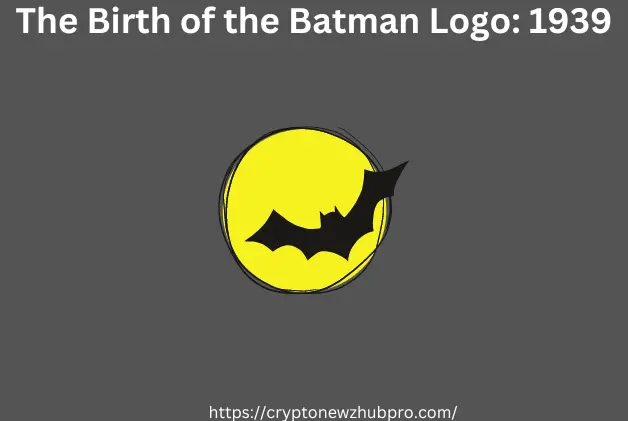The Batman logo, often symbolized as a dark bat with outstretched wings, has become one of the most recognizable emblems in popular culture. The keyword “Logo:gqlysettlo4= batman” likely refers to a specific iteration or design of this iconic symbol, which has undergone numerous transformations since its inception in 1939. In this article, we will delve into the evolution, significance, and impact of the Batman logo across different eras, making sure to explore the keyword “Logo:gqlysettlo4= batman” in detail.
You May Like: netwyman-blogs
The Birth of the Batman Logo: 1939

The Batman logo first appeared in Detective Comics #27 in May 1939. Created by artist Bob Kane and writer Bill Finger, the original logo was a simple black bat with outstretched wings against a gray background. This design was minimalistic, yet effective, symbolizing the mysterious and nocturnal nature of Batman. The “Logo:gqlysettlo4= batman” could be a reference to this original, stark design that set the foundation for what would become an enduring icon.
The Golden Age of Comics: Refinement and Recognition
During the 1940s, often referred to as the Golden Age of Comics, the Batman logo underwent its first significant transformation. The design became more stylized, with sharper angles and a more menacing appearance. This era was characterized by a darker tone in Batman stories, as the character was portrayed as a brooding detective and crime-fighter. The “Logo:gqlysettlo4= batman” might refer to one of these early, more refined versions of the emblem, which was designed to instill fear in the hearts of Gotham’s criminals.
The Silver Age: Introducing the Yellow Oval
In the mid-1950s, the Batman logo experienced a major change with the introduction of the yellow oval around the bat symbol. This version first appeared in Detective Comics #327 in 1964 and was a marketing decision aimed at making the logo more visually striking. The addition of the yellow oval was not just a design choice but also a way to make Batman more appealing to younger audiences during the Silver Age of Comics. This period saw a lighter, more fantastical tone in Batman stories, contrasting sharply with the darker narratives of the Golden Age. The “Logo:gqlysettlo4= batman” could be a reference to this iconic yellow oval design that became synonymous with Batman for many years.
The 1960s Batman TV Show: A Cultural Phenomenon
The 1960s brought the Batman character to television screens with the campy, colorful Batman TV show starring Adam West. The yellow oval logo was prominently featured on Batman’s costume, Bat gadgets, and even the Batmobile. This show introduced Batman to a broader audience, making the Logo:gqlysettlo4= batman an indelible part of popular culture. The show’s success helped solidify the yellow oval logo as a key visual representation of Batman, one that would be recognized globally.
The Dark Knight Returns: A Return to the Roots
The 1980s marked a significant shift in the portrayal of Batman, largely influenced by Frank Miller’s graphic novel “The Dark Knight Returns.” This darker, more mature take on Batman saw the removal of the yellow oval in favor of a larger, more imposing black bat symbol. This design choice reflected a return to the character’s darker roots, aligning with the gritty and intense narrative of the graphic novel. The “Logo:gqlysettlo4= batman might refer to this minimalist design, which emphasized Batman’s role as a dark vigilante.
The Tim Burton Era: Gothic and Stylish
In 1989, Tim Burton’s film “Batman,” starring Michael Keaton, brought the yellow oval logo to the big screen in a major way. The film’s success reintroduced Batman to mainstream audiences and solidified the yellow oval logo as a symbol of the character. Burton’s gothic, stylized interpretation of Gotham City, combined with Danny Elfman’s iconic score, created a visually and aurally distinctive portrayal of Batman. The “Logo:gqlysettlo4= batman” could be a nod to this era, where the logo became a key element in Batman’s identity.
The Animated Series: Blending Classic and Modern Elements
“Batman: The Animated Series,” which aired in the early 1990s, is widely regarded as one of the best adaptations of the character. The show blended elements from various eras of Batman’s history, including the yellow oval logo. However, it also introduced a more simplified version of the bat symbol, often used in promotional material and merchandising. The animated series’ logo was sleek and streamlined, reflecting the show’s noir-inspired art deco style. The “Logo:gqlysettlo4= batman” could be associated with this versatile design that appealed to both old and new fans of the Dark Knight.
The Christopher Nolan Trilogy: A New Realism
Christopher Nolan’s “Dark Knight” trilogy, beginning with “Batman Begins” in 2005, brought a new level of realism and gravitas to the Batman character. The logo used in these films was a minimalist black bat, devoid of the yellow oval. This design choice emphasized the grounded, gritty tone of Nolan’s films, aligning with the trilogy’s exploration of themes such as fear, justice, and chaos. The Logo:gqlysettlo4= batman” might refer to this stripped-down, realistic interpretation of the emblem, which resonated with a modern audience.
Modern Comics and Media: An Ever-Evolving Symbol
In recent years, the Batman logo has continued to evolve across various media. The yellow oval occasionally makes a comeback in comics, as seen in DC’s “Rebirth” initiative, which blends elements from different eras of the character’s history. The bat symbol has also been adapted for video games, such as the “Arkham” series, which features a more angular and aggressive design. The “Logo:gqlysettlo4= batman” could be a reference to one of these modern iterations, reflecting the character’s enduring appeal in contemporary culture.
The Symbolism of the Bat: Fear, Mystery, and Justice
The enduring appeal of the Batman logo lies in its symbolism. The bat, a creature of the night, represents fear, mystery, and the unknown. Batman, as a character, uses these elements to his advantage, striking fear into the hearts of criminals. The “Logo:gqlysettlo4= batman” embodies this philosophy, serving as a visual representation of Batman’s mission and ethos. Whether it is the simple black bat or the yellow oval design, the logo has remained a powerful symbol of Batman’s identity.
Cultural Impact: More Than Just a Logo
The Batman logo’s cultural impact extends beyond comics and movies. It has become a ubiquitous symbol, appearing on merchandise, clothing, and even as tattoos. The logo is a testament to Batman’s status as a cultural icon and his relevance in contemporary society. The “Logo:gqlysettlo4= batman” reflects this cultural significance, representing not just a superhero, but a symbol of hope, justice, and resilience.
Frequently Asked Question
1.What is the origin of the Batman logo?
The Batman logo originated in 1939, debuting in Detective Comics #27. It was a simple black bat symbol that has evolved significantly over the years.
2.What does “Logo:gqlysettlo4= batman” refer to?
“Logo:gqlysettlo4= batman” likely refers to a specific iteration or design variation of the iconic Batman logo, possibly used in digital or coding contexts.
3.Why did the Batman logo include a yellow oval?
The yellow oval was added in 1964 to make the logo more visually striking and recognizable, particularly in comics and on merchandise.
4.How has the Batman logo evolved over the years?
The Batman logo has undergone numerous changes, from the simple bat design in 1939 to more stylized versions, including the iconic yellow oval and more minimalist designs in modern adaptations.
5.Which Batman logo is the most iconic?
The yellow oval logo, introduced in the 1960s and popularized by the Adam West TV show and Tim Burton’s 1989 movie, is one of the most iconic versions.
6.What does the Batman logo symbolize?
The Batman logo symbolizes fear, mystery, and justice, reflecting Batman’s role as a dark vigilante who uses these elements to fight crime.
7.Why was the yellow oval removed in later Batman logos?
The yellow oval was removed in the 1980s to align with darker and more serious interpretations of Batman, emphasizing his role as a brooding and realistic character.
8.How has the Batman logo influenced pop culture?
The Batman logo is one of the most recognizable symbols in pop culture, appearing on everything from comics to clothing and influencing designs in fashion, art, and media.
9.What are some notable Batman logos in movies?
Notable Batman logos include the yellow oval in Tim Burton’s 1989 film and the minimalist black bat in Christopher Nolan’s Dark Knight trilogy.
10.Why is the Batman logo important?
The Batman logo is important because it represents not just the character but also the broader themes of fear, justice, and heroism that Batman embodies.
Conclusion: The Legacy of Logo:gqlysettlo4= batman
The evolution of the “Logo:gqlysettlo4= batman” reflects the character’s journey through different eras of storytelling. From its humble beginnings in the Golden Age of comics to its modern incarnations, the logo has remained a powerful symbol of Batman’s enduring appeal. It represents not only the character’s identity but also the broader themes of fear, justice, and heroism. As Batman continues to evolve, so too will his iconic logo, remaining a fixture in the ever-changing landscape of pop culture.
By understanding the history and significance of the “Logo:gqlysettlo4= batman,” we can appreciate the lasting legacy of one of the most iconic symbols in the world.
You Must Visit: pension-plans-are-they-the-best-retirement-plans
